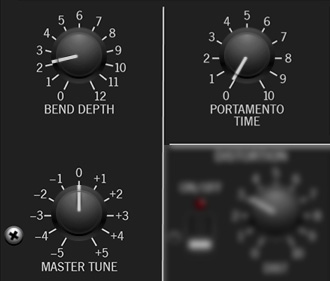
Voice Assigner Section
PS-20 can play up to 16 simultaneous polyphonic voices. The Voice Assign section regulates how the voices are played.
Max Voices and LED display- Sets and displays the maximum number of notes that can simultaneously play, from 2 to 16. Increase or decrease the total voices with the up/down arrow buttons.
Random Pan- Randomly distributes notes across the stereo field when in Poly 1 or Poly 2 mode. Random Pan has no effect if Mono or Uni mode is currently selected; the LED will turn off if Mono or Uni mode is chosen.
Chord Memory- Allows chords to be memorized and played with single keys. To memorize a chord, make sure Poly 1 or Poly 2 mode is selected, then click the slide switch. The LED flashes to indicate that it's in learn mode. To learn a chord, play up to 16 notes (this is limited by the current Number Of Voices setting); when the last note is released, the chord is memorized and the LED glows solid. To disable Chord mode, click the button again.
Chord Memory and Max Voices- The Max Voices setting automatically changes to the number of voices in the programmed chord. If the the Max Voices setting is reduced, notes are disabled. Chord notes will return as the Max Voices setting is increased.
Note that Chord mode isn't just for "chords" per se; it can be used for octaves, fifths, or any desired combination of notes.
Voice Assign Modes
Poly 1- This the standard polyphonic mode. If the number of notes played exceeds the current maximum setting, it uses a sophisticated allocation scheme to steal the most recently played notes. In use, this means if you're holding a bass note with your left hand, it won't disappear while playing chords and melodies with your right hand.
Poly 2- Poly 2's allocation is optimized for use with PS-20's portamento (glide) function - it does an impressively good job of "knowing" which notes to glide from and to when holding notes while playing melodies (regardless of whether notes are played legato or separately).
Mono- One note can be played a time with one voice sounding. Max Voices will change to 1 when Mono is selected. Mono mode is last-note priority - this means the most recently played note will always sound.
Unison- One note sounds at a time with multiple voices will stacking according to the current Max Voices setting.
Big Warning About MIDI MPE Mode: PS-20 supports MIDI MPE mode, a fancy protocol that allows articulation of multiple parameters on a per-note basis (you'll know if you own an MPE-compatible controller). If the Voice Assigner slide switch and Max Voices controls turn gray and don't seem to work, ensure that MIDI MPE mode isn't enabled (Settings gear in the top purple menu bar, Interface tab, uncheck Enable MPE Mode.)
Detune- Randomly "spreads" the tuning of the oscillators when Unison mode is selected for super fat sounds.
Stereo Spread- Randomly distributes notes across the stereo image when the Unison mode is selected. It has no effect in Poly 1, Poly 2, or Mono mode, and the LED will shut off if they're selected with the Stereo Spread switch is on.
Trigger Mode- When Multi is selected, PS-20's envelopes will retrigger from the start every time a new key is pressed. If Single is selected, the envelopes will only retrigger if no other notes are currently held. Single mode is useful for emulating the sounds of some acoustic instruments - for example, the sound of plucking a note on a guitar, then sliding on the string to different notes without plucking again. Multi mode generally feels more responsive to play and is useful for more aggressive passages.
Pitch Settings

Master Tune- Tunes the entire instrument up or down by just over five semitones.
Bend Depth- Determines how PS-20 responds to incoming MIDI pitch bend data. The pitch bend range can be set from zero up to one octave.
Portamento Time- Also known as glide, Portamento causes notes to slide smoothly from one pitch to the next. Increasing the knob setting slows glide speed as it's increased. Portamento works in all voice modes; if you'd like to use it polyphonically, we recommend using Poly 2 mode.